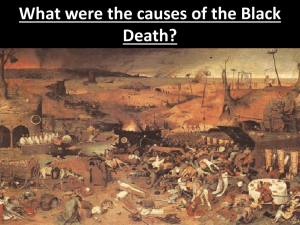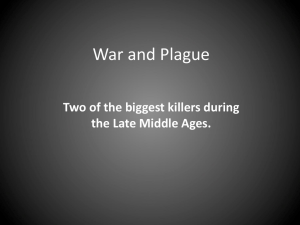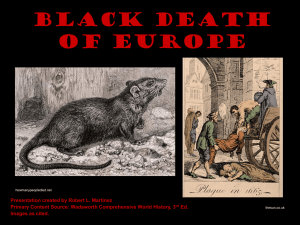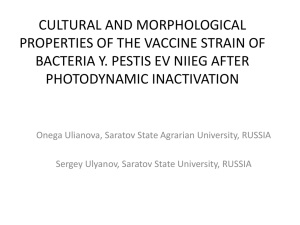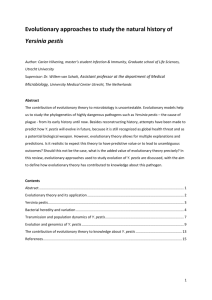Bubonic Plague
advertisement
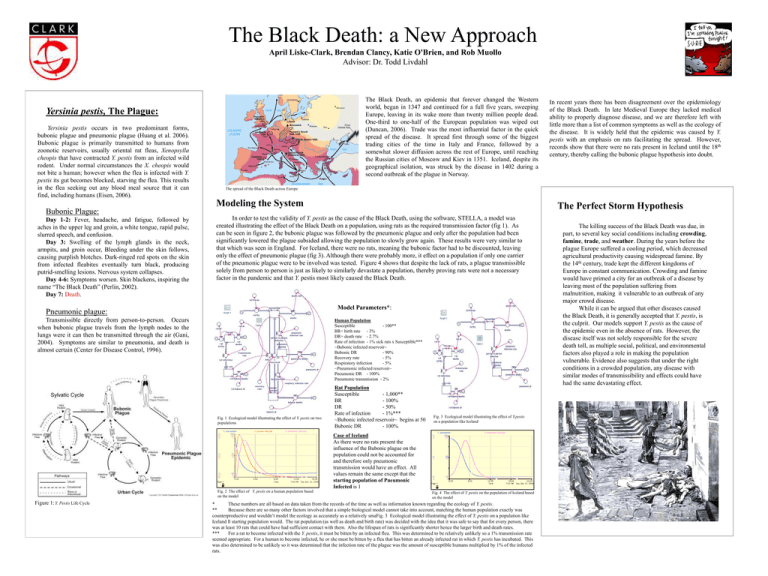
The Black Death: a New Approach April Liske-Clark, Brendan Clancy, Katie O'Brien, and Rob Muollo Advisor: Dr. Todd Livdahl The Black Death, an epidemic that forever changed the Western world, began in 1347 and continued for a full five years, sweeping Europe, leaving in its wake more than twenty million people dead. One-third to one-half of the European population was wiped out (Duncan, 2006). Trade was the most influential factor in the quick spread of the disease. It spread first through some of the biggest trading cities of the time in Italy and France, followed by a somewhat slower diffusion across the rest of Europe, until reaching the Russian cities of Moscow and Kiev in 1351. Iceland, despite its geographical isolation, was struck by the disease in 1402 during a second outbreak of the plague in Norway. Yersinia pestis, The Plague: Yersinia pestis occurs in two predominant forms, bubonic plague and pneumonic plague (Huang et al. 2006). Bubonic plague is primarily transmitted to humans from zoonotic reservoirs, usually oriental rat fleas, Xenopsylla cheopis that have contracted Y. pestis from an infected wild rodent. Under normal circumstances the X. cheopis would not bite a human; however when the flea is infected with Y. pestis its gut becomes blocked, starving the flea. This results in the flea seeking out any blood meal source that it can find, including humans (Eisen, 2006). The spread of the Black Death across Europe Modeling the System The Perfect Storm Hypothesis Bubonic Plague: Day 1-2: Fever, headache, and fatigue, followed by aches in the upper leg and groin, a white tongue, rapid pulse, slurred speech, and confusion. Day 3: Swelling of the lymph glands in the neck, armpits, and groin occur, Bleeding under the skin follows, causing purplish blotches. Dark-ringed red spots on the skin from infected fleabites eventually turn black, producing putrid-smelling lesions. Nervous system collapses. Day 4-6: Symptoms worsen. Skin blackens, inspiring the name “The Black Death” (Perlin, 2002). Day 7: Death. In order to test the validity of Y. pestis as the cause of the Black Death, using the software, STELLA, a model was created illustrating the effect of the Black Death on a population, using rats as the required transmission factor (fig 1). As can be seen in figure 2, the bubonic plague was followed by the pneumonic plague and only after the population had been significantly lowered the plague subsided allowing the population to slowly grow again. These results were very similar to that which was seen in England. For Iceland, there were no rats, meaning the bubonic factor had to be discounted, leaving only the effect of pneumonic plague (fig 3). Although there were probably more, it effect on a population if only one carrier of the pneumonic plague were to be involved was tested. Figure 4 shows that despite the lack of rats, a plague transmissible solely from person to person is just as likely to similarly devastate a population, thereby proving rats were not a necessary factor in the pandemic and that Y. pestis most likely caused the Black Death. Model Parameters*: Pneumonic plague: Transmissible directly from person-to-person. Occurs when bubonic plague travels from the lymph nodes to the lungs were it can then be transmitted through the air (Gani, 2004). Symptoms are similar to pneumonia, and death is almost certain (Center for Disease Control, 1996). Human Population Susceptible - 100** BR= birth rate - 3% DR= death rate - 2.7% Rate of infection - 1% sick rats x Susceptible*** ~Bubonic infected reservoir~ Bubonic DR - 90% Recovery rate - 5% Respiratory infection - 5% ~Pneumonic infected reservoir~ Pneumonic DR - 100% Pneumonic transmission - 2% Fig. 1 Ecological model illustrating the effect of Y. pestis on two populations Rat Population Susceptible - 1,000** BR - 100% DR - 50% Rate of infection - 1%*** ~Bubonic infected reservoir~ begins at 50 Bubonic DR - 100% Fig. 3 Ecological model illustrating the effect of Y.pestis on a population like Iceland Case of Iceland As there were no rats present the influence of the Bubonic plague on the population could not be accounted for and therefore only pneumonic transmission would have an effect. All values remain the same except that the starting population of Pneumonic Infected is 1 Fig. 2 The effect of Y. pestis on a human population based on the model Figure 1: Y. Pestis Life Cycle In recent years there has been disagreement over the epidemiology of the Black Death. In late Medieval Europe they lacked medical ability to properly diagnose disease, and we are therefore left with little more than a list of common symptoms as well as the ecology of the disease. It is widely held that the epidemic was caused by Y. pestis with an emphasis on rats facilitating the spread. However, records show that there were no rats present in Iceland until the 18th century, thereby calling the bubonic plague hypothesis into doubt. Fig. 4 The effect of Y. pestis on the population of Iceland based on the model * These numbers are all based on data taken from the records of the time as well as information known regarding the ecology of Y. pestis. ** Because there are so many other factors involved that a simple biological model cannot take into account, matching the human population exactly was counterproductive and wouldn’t model the ecology as accurately as a relatively smaFig. 3 Ecological model illustrating the effect of Y. pestis on a population like Iceland ll starting population would. The rat population (as well as death and birth rate) was decided with the idea that it was safe to say that for every person, there was at least 10 rats that could have had sufficient contact with them. Also the lifespan of rats is significantly shorter hence the larger birth and death rates. *** For a rat to become infected with the Y. pestis, it must be bitten by an infected flea. This was determined to be relatively unlikely so a 1% transmission rate seemed appropriate. For a human to become infected, he or she must be bitten by a flea that has bitten an already infected rat in which Y. pestis has incubated. This was also determined to be unlikely so it was determined that the infection rate of the plague was the amount of susceptible humans multiplied by 1% of the infected rats. The killing success of the Black Death was due, in part, to several key social conditions including crowding, famine, trade, and weather. During the years before the plague Europe suffered a cooling period, which decreased agricultural productivity causing widespread famine. By the 14th century, trade kept the different kingdoms of Europe in constant communication. Crowding and famine would have primed a city for an outbreak of a disease by leaving most of the population suffering from malnutrition, making it vulnerable to an outbreak of any major crowd disease. While it can be argued that other diseases caused the Black Death, it is generally accepted that Y. pestis, is the culprit. Our models support Y. pestis as the cause of the epidemic even in the absence of rats. However, the disease itself was not solely responsible for the severe death toll, as multiple social, political, and environmental factors also played a role in making the population vulnerable. Evidence also suggests that under the right conditions in a crowded population, any disease with similar modes of transmissibility and effects could have had the same devastating effect.
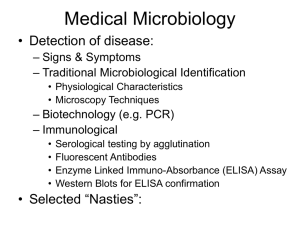
![[Presentation by Sara Morgans].](http://s2.studylib.net/store/data/005578977_1-95120715b429730785aca2fdba9a2208-300x300.png)
